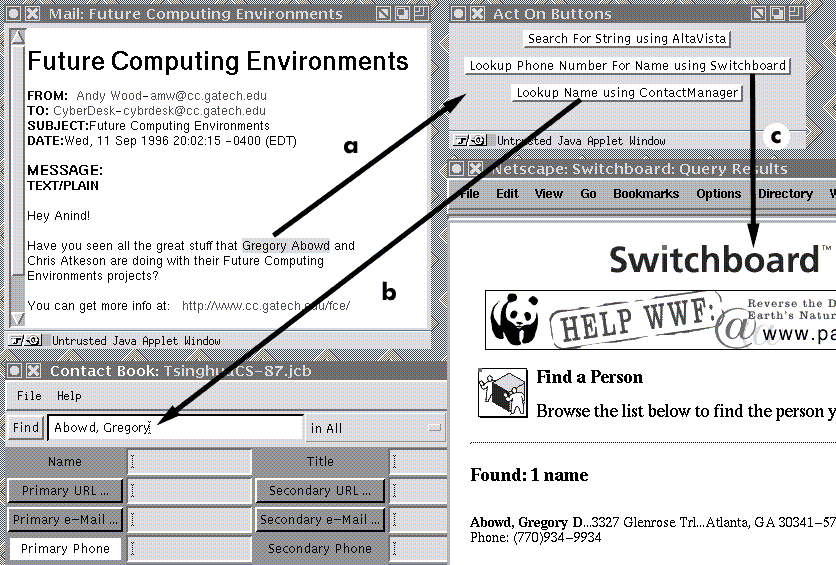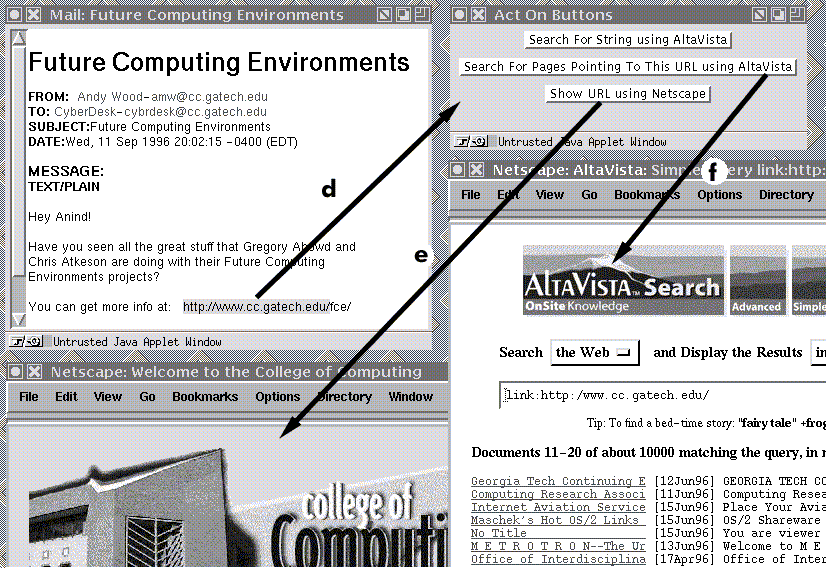

Anind K. Dey, Gregory D. Abowd
Graphics, Visualization & Usability Center
Georgia Institute of Technology
Atlanta, GA 30332-0280 USA
+1-404-894-7512
{anind, abowd}@cc.gatech.edu
One approach to integration is a tightly-integrated suite of tools that take advantage of known services. This approach, available in many commercial personal productivity products, is unsatisfactory for two reasons. First, it requires the designer to predict how the user will want to integrate a set number of services. Second, it forces the user either to be satisfied with what the designer has provided or to program additional and sometimes complex relationships between existing services. The CyberDesk prototype shows that it is possible, however, to provide a service integration framework that removes most of the programming burden (of designer and end-user), provides greater flexibility to the user and automatically suggests how two services can be integrated based on natural user input. For example, while the user is reading some mail, simply highlighting someone's name in the message can trigger the system to inform the user of all of the services available that are relevant to that name. The e-mail tool in Netscape offers similar but limited functionality in automatically recognizing URLs and e-mail addresses.
For example, at the top left in Figure 1, is an e-mail message informing Anind about the great work going on in the Future Computing Environments group at Georgia Tech. Anind is intrigued and decides to investigate further. Highlighting "Gregory Abowd" causes the ActOn button bar to suggest some actions (a). One suggestion is to look up the name in an available contact manager (b). Anind discovers that he doesn't have Gregory's phone number, so he decides to follow another suggestion and initiates a search using the Switchboard Web service (c).

Figure 1: A sample interaction with the CyberDesk. Highlighting a name in the e-mail browser suggests several other actions that can be performed using that name.
Figure 2 continues the scenario. After speaking with Gregory, Anind wants to visit Georgia Tech, but first he will do some research. He selects the first part of the URL given in the message, and the ActOn buttons change (d). Anind decides to view the URL (e) and use AltaVista to retrieve a list of Web pages that reference the URL (f). He is pleasantly surprised by this last option, as he was not aware that such a service even existed.

Figure 2: Continuing the scenario with CyberDesk. Selecting only part of a URL in the e-mail message suggests further integrating behavior.

Figure 3: The run-time architecture of CyberDesk.
When the user selects information displayed by one service, say some text from the e-mail message, the type converters try recursively to see if the data can be converted to other types used in the system (e.g. a name in Figure 3). In the case of plain text, this could be done by comparing the string to common formats for representing the various types; for names you might use title firstname lastname and similar patterns can be used for dates, URLs, e-mail and mailing addresses. The type converters do not have to be overly clever, as the user provides a very focused subset of the data to look at by explicitly selecting it.
Finally, the user's selection, plus any extra type information generated by the conversion process, is observed by the ActOn integrating applet and a set of potential actions for that data is suggested. For example, a name is accepted as input by the Switchboard service, and so ActOn creates a button that suggests that integrating behaviour. Clicking on the button invokes the Switchboard service, completing the integration without requiring any change to the functionality of either service and without any programming effort from the user.
From the user's perspective, CyberDesk offers tight integration between different services, but with the freedom to introduce new services, and upgrade old services without a loss of integrating power. Integrating behavior is actively suggested by the system, removing the need for the user to remember how services work together. It is fairly clear from our use of CyberDesk that it suffers from the potential problem of having too many ActOn buttons generated; the user could be swamped by too many choices in an ever-expanding button bar. We can certainly investigate different interface representations of the button bar to help manage this. It will be more interesting to apply some intelligence to the ActOn applet to use contextual information and user history in determining the relevance of potential future actions and reduce the number of suggestions.
Another potential user problem is the reaction to a constantly changing interface. There is a clear link between our work and the adaptive user interface community. However, most of that literature concentrates on adapting a computer interface to the changing capabilities of the user, not changing capabilities of the software environment [2].

